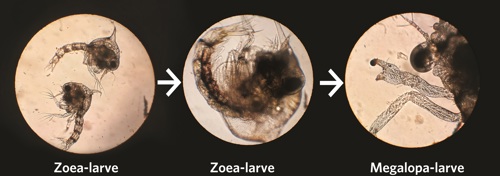
Proudly, zookeeper Tim te Vruchte offers us a glimpse of the successful breeding area for fiddler crabs behind the scenes in the Mangrove. His pride is justifiable because, together with biologist Max Janse, the Mangrove team has achieved something special. Breeding fiddler crabs is a meticulous and delicate process that is still being pioneered; Burgers' Zoo has its first captive-bred fiddler crabs!
Tim explains that the breeding process started with extensive preparation. First, with the help of the knowledge and experience of a German private hobbyist, a system was constructed behind the scenes of the Mangrove. A small group of fiddler crabs is kept here to breed them. In the public area of the Mangrove, the female crabs are regularly seen carrying egg clutches. Tim describes the reproduction of fiddler crabs: "They mate in small burrows in the mudflats, after which the females produce clutches of fertilised eggs. A clutch is a minuscule cluster of eggs, which the female keeps in a mass on the underside of her body and which she constantly provides with fresh water and cleans."
About a week and a half to two weeks later, the females sprint more or less en masse from the mudflats to the water to lay their eggs, which hatch soon after. Tim and his colleagues have to be on high alert now, both in the breeding set-up and in the public area, as they have to fish the tiny larvae out of the water as quickly and efficiently as possible and transport them to another system. Otherwise, there is a good chance that they will disappear into the filter or—in the public area—be eaten by other animals.
Then the challenge begins. The tiny larvae eat tiny food: Brachionus, a kind of animal plankton. So, the zookeepers breed food to keep the Brachionus alive, as well. Microscopic marine algae, also known as phytoplankton, which is also partially eaten by the fiddler larvae. It is also important that the larvae keep moving in the water. For that purpose, a constant, very subtle current is required in a so-called Kreisel, a circular, vertical aquarium. As both crab larvae and their food are minuscule and exceptionally sensitive and fragile, caution, accuracy and precision are very important at this stage. Water quality and temperature are also important factors.
"This process is special because we had to learn a lot through experimentation since so much is still unknown about the breeding of fiddler crabs," says Tim. "The larvae go through three stages and moult very often in order to grow. After the first larval stage, known as the zoeae stage, in which they moult five to six times, they go through a transformation and achieve the megalopa stage—a fiddler crab with a tail. After another two or three more moults, they finally reach the stage of miniature fiddler crab without a tail."
We are essentially creating our own little ecosystem with special air treatment, gentle water movement and a constant supply of available food in the form of algae growth, among other things. At least five crabs from the first "batch" have now grown to about two centimetres. It won't be long before the captive-bred animals are released in the public area.
Tim tells us that the team has learned a lot from the process, but they still have some questions. Much is still unknown or at least has never been scientifically described. For example, the transition phase from the first larval stage to the second still suffers many losses in our breeding set-up. Each size larvae also requires a specific size of feeding item, which is a challenge. If this doesn't go well, they eagerly take to cannibalism as an alternative. Maybe that explains the loss? Maybe there are many losses suffered in nature as well, as transforming from a larva to a crab is quite an undertaking.
Even though biologists and zookeepers know a lot about animal life, many things are still unbeknownst to us. Thanks to this inspiring pioneering work, we are learning more and more about animals and nature! Hopefully, we will soon be able to give another update in ZieZoo about the progress of our breeding process.
